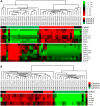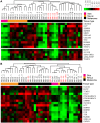A gene expression signature of invasive potential in metastatic melanoma cells
- PMID: 20041153
- PMCID: PMC2794539
- DOI: 10.1371/journal.pone.0008461
A gene expression signature of invasive potential in metastatic melanoma cells
Abstract
Background: We are investigating the molecular basis of melanoma by defining genomic characteristics that correlate with tumour phenotype in a novel panel of metastatic melanoma cell lines. The aim of this study is to identify new prognostic markers and therapeutic targets that might aid clinical cancer diagnosis and management.
Principal findings: Global transcript profiling identified a signature featuring decreased expression of developmental and lineage specification genes including MITF, EDNRB, DCT, and TYR, and increased expression of genes involved in interaction with the extracellular environment, such as PLAUR, VCAN, and HIF1a. Migration assays showed that the gene signature correlated with the invasive potential of the cell lines, and external validation by using publicly available data indicated that tumours with the invasive gene signature were less melanocytic and may be more aggressive. The invasion signature could be detected in both primary and metastatic tumours suggesting that gene expression conferring increased invasive potential in melanoma may occur independently of tumour stage.
Conclusions: Our data supports the hypothesis that differential developmental gene expression may drive invasive potential in metastatic melanoma, and that melanoma heterogeneity may be explained by the differing capacity of melanoma cells to both withstand decreased expression of lineage specification genes and to respond to the tumour microenvironment. The invasion signature may provide new possibilities for predicting which primary tumours are more likely to metastasize, and which metastatic tumours might show a more aggressive clinical course.
Conflict of interest statement
Figures





Similar articles
-
Gene expression profiles of human melanoma cells with different invasive potential reveal TSPAN8 as a novel mediator of invasion.Br J Cancer. 2011 Jan 4;104(1):155-65. doi: 10.1038/sj.bjc.6605994. Epub 2010 Nov 16. Br J Cancer. 2011. PMID: 21081927 Free PMC article.
-
Integrative genome comparison of primary and metastatic melanomas.PLoS One. 2010 May 24;5(5):e10770. doi: 10.1371/journal.pone.0010770. PLoS One. 2010. PMID: 20520718 Free PMC article.
-
MiR-21 enhances melanoma invasiveness via inhibition of tissue inhibitor of metalloproteinases 3 expression: in vivo effects of MiR-21 inhibitor.PLoS One. 2015 Jan 14;10(1):e0115919. doi: 10.1371/journal.pone.0115919. eCollection 2015. PLoS One. 2015. PMID: 25587717 Free PMC article.
-
Gene signature of the metastatic potential of cutaneous melanoma: too much for too little?Clin Exp Metastasis. 2010 Aug;27(6):371-87. doi: 10.1007/s10585-010-9307-2. Epub 2010 Feb 24. Clin Exp Metastasis. 2010. PMID: 20177751 Review.
-
Gene expression profiling of primary cutaneous melanoma.Verh K Acad Geneeskd Belg. 2007;69(1):23-45. Verh K Acad Geneeskd Belg. 2007. PMID: 17427873 Review.
Cited by
-
Genomic and signalling pathway characterization of the NZM panel of melanoma cell lines: A valuable model for studying the impact of genetic diversity in melanoma.Pigment Cell Melanoma Res. 2021 Jan;34(1):136-143. doi: 10.1111/pcmr.12908. Epub 2020 Jul 4. Pigment Cell Melanoma Res. 2021. PMID: 32567790 Free PMC article.
-
Comparison of Global DNA Methylation Patterns in Human Melanoma Tissues and Their Derivative Cell Lines.Cancers (Basel). 2021 Apr 28;13(9):2123. doi: 10.3390/cancers13092123. Cancers (Basel). 2021. PMID: 33924927 Free PMC article.
-
Fibroblast-induced switching to the mesenchymal-like phenotype and PI3K/mTOR signaling protects melanoma cells from BRAF inhibitors.Oncotarget. 2016 Apr 12;7(15):19997-20015. doi: 10.18632/oncotarget.7671. Oncotarget. 2016. PMID: 26918352 Free PMC article.
-
Reprogramming human A375 amelanotic melanoma cells by catalase overexpression: Upregulation of antioxidant genes correlates with regression of melanoma malignancy and with malignant progression when downregulated.Oncotarget. 2016 Jul 5;7(27):41154-41171. doi: 10.18632/oncotarget.9273. Oncotarget. 2016. PMID: 27206673 Free PMC article.
-
The classification of melanocytic gene signatures.Pigment Cell Melanoma Res. 2024 Nov;37(6):854-863. doi: 10.1111/pcmr.13189. Epub 2024 Jul 28. Pigment Cell Melanoma Res. 2024. PMID: 39072997
References
-
- Hocker TL, Singh MK, Tsao H. Melanoma genetics and therapeutic approaches in the 21st century: moving from the benchside to the bedside. J Invest Dermatol. 2008;128:2575–2595. - PubMed
-
- Francken AB, Accortt NA, Shaw HM, Wiener M, Soong SJ, et al. Prognosis and determinants of outcome following locoregional or distant recurrence in patients with cutaneous melanoma. Ann Surg Oncol. 2008;15:1476–1484. - PubMed
-
- Balch CM, Soong SJ, Gershenwald JE, Thompson JF, Reintgen DS, et al. Prognostic factors analysis of 17,600 melanoma patients: validation of the American Joint Committee on Cancer melanoma staging system. J Clin Oncol. 2001;19:3622–3634. - PubMed
Publication types
MeSH terms
Substances
LinkOut - more resources
Full Text Sources
Medical
Molecular Biology Databases
Research Materials

